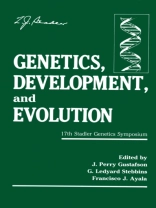One outstanding question in biology is the problem of devel- opment: how the genetic instructions encoded in the DNA become expressed in the morphological, physiological, and behavioral features of multicellular organisms, through an ordered sequence of events that extend from the first cell division of the zygote to the adult stage and eventual death. The problem is how a one- dimensional array of instructions is transformed into a four- dimensional entity, the organism that exists in space and time. Understanding this transformation is, nevertheless, necessary for mastering the process of evolution. One hundred and twenty-five years after The Origin of Species, we have gained some understanding of evolution at the genetic level. Genetic information is stored in the linear sequence of nucleotides in the DNA. Gene mutations, chromosomal reorganiza- tions, and a host of related processes introduce variation in the sequence and the amount of DNA. The fate of these variations is determined by interactions within the genome and with the outside environment that are largely understood. We have recently gained a glimpse of how the genome of eukaryotes is organized and will learn much more about it in the future, now that we have the research tools for it.
Francisco J. Ayala & J. Perry Gustafson
Genetics, Development, and Evolution [PDF ebook]
17th Stadler Genetics Symposium
Genetics, Development, and Evolution [PDF ebook]
17th Stadler Genetics Symposium
ซื้อ eBook เล่มนี้และรับฟรีอีก 1 เล่ม!
ภาษา อังกฤษ ● รูป PDF ● ISBN 9781468451375 ● สำนักพิมพ์ Springer US ● การตีพิมพ์ 2013 ● ที่สามารถดาวน์โหลดได้ 3 ครั้ง ● เงินตรา EUR ● ID 4616019 ● ป้องกันการคัดลอก Adobe DRM
ต้องใช้เครื่องอ่านหนังสืออิเล็กทรอนิกส์ที่มีความสามารถ DRM












